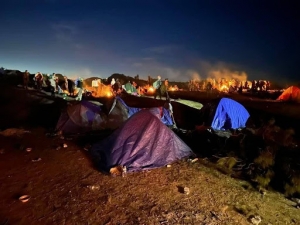LA MESA SETS HISTORIC FIRST WITH DIVERSE CITY COUNCIL THAT INCLUDES FOUR WOMEN, LATINA, ASIAN, BLACK, AND LGBTQ+ REPRESENTATIVES
Photo, left to right: Councilmembers Lauren Cazares and Patricia Dillard, Mayor Mark Arapostathis, Councilmembers Laura Lothian and Genevieve Suzuki
Source: City of La Mesa
January 10, 2025 (La Mesa) – The City of La Mesa welcomed two new councilmembers during its City Council meeting on Tuesday, Dec. 10. The occasion marked a historic milestone in La Mesa as the council now consists of a majority of women, including women of color, with four women and one man who serves as mayor.
“This is a proud and historic moment for La Mesa,” said Mayor Mark Arapostathis. “Our City Council reflects the strength and diversity of our community. I look forward to working alongside my colleagues to continue making La Mesa a place where everyone feels represented and empowered.”
Joining the council are the newly elected members, Lauren Cazares and Genevieve Suzuki. Both Cazares and Suzuki have deep roots in the La Mesa community. Cazares, lifelong La Mesan, currently serves as Policy Advisor at the San Diego Regional Chamber of Commerce and has been actively involved in various boards and committees, including the City of La Mesa Community Police Oversight Board.
“I‘m deeply honored to serve as a member of the La Mesa City Council and continue the work of building a safer, stronger, more affordable community for all,” said Councilmember Cazares. “As a proud Latina, the youngest Councilwoman in La Mesa history and first openly LGBTQ+ Councilmember, I’m committed to ensuring that our City remains a place where everyone feels heard, valued, and empowered to thrive.”
Suzuki, a family law attorney with more than a decade of legal experience, is a dedicated advocate committed to community service in La Mesa. She has served on the Community Services Commission and the La Mesa Park and Recreation Foundation Board.
“I'm honored to have been elected to represent our vibrant community and work with Mayor Arapostathis, Vice Mayor Patricia Dillard, and fellow Councilmembers Laura Lothian and Lauren Cazares,” said Councilmember Suzuki. “I look forward to making sure everyone feels heard and using my time on the City Council to continue the progress made by outgoing councilmembers Colin Parent and Jack Shu.”
The election of these new councilmembers by the people of La Mesa reflects the city’s diverse makeup, with women representing approximately 52% of the population. This milestone builds on the foundation set in 1980 when Jerri Lopez was elected La Mesa’s first female City Councilmember.
“History, history, and more history! I’m thrilled to have made history at Tuesday’s final City Council meeting of the year,” said Vice Mayor Patricia Dillard. “I’m especially excited to welcome our two new Councilmembers, Lauren Cazares and Genevieve Suzuki, as they were sworn in helping form a supermajority female council. Together, we will continue to represent our community with dedication and excellence. Four highly qualified women, each with diverse multicultural backgrounds, are poised to lead. Congratulations to us all!"
“I first attended La Mesa City Council meetings when the council comprised of Mayor Art Madrid and Councilmembers Dr. A, Ernie Ewin, Ruth Sterling and Dave Allen,” said Councilmember Laura Lothian. “Since then, our City Council has always been majority male. This new council, with four women and one man, will be very different and interesting. We are a diverse council, with a Greek mayor and the four councilmembers who are female, Black, Hispanic, and Asian. My ethnic background is half Guatemalan and half English. We are also diverse in age, with Vice Mayor Dillard and I being grandmothers, Genevieve Suzuki as a young mom, and Lauren Cazares, the youngest councilmember elected since the 1970s!”
Cazares and Suzuki are replacing Colin Parent and Jack Shu on the City Council. Parent served on the City Council for eight years, where he focused on housing policies and championed labor initiatives. Shu served on the City Council for four years, earning recognition for his commitment to environmental advocacy.
The swearing-in ceremony took place during the City Council’s regular meeting.
The City encourages residents to engage with the new councilmembers and participate in upcoming City Council meetings. Meetings are held on the second and fourth Tuesday of each month at 6 p.m. in the Council Chambers, located at 8130 Allison Ave., La Mesa.
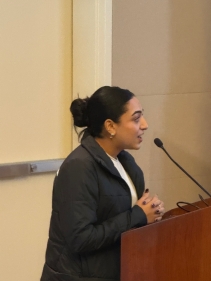 Leila Kater (photo, left) testified that she represents almost 2,000 healthcare workers in the Grossmont district. She told the board that workers “will start paying a lot more attention to these meetings” in order to “hold this board accountable.”
Leila Kater (photo, left) testified that she represents almost 2,000 healthcare workers in the Grossmont district. She told the board that workers “will start paying a lot more attention to these meetings” in order to “hold this board accountable.”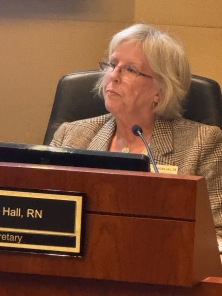 After public testimony, the board held a discussion led by board president Bob Ayres, who thanked everyone for sharing their views.
After public testimony, the board held a discussion led by board president Bob Ayres, who thanked everyone for sharing their views.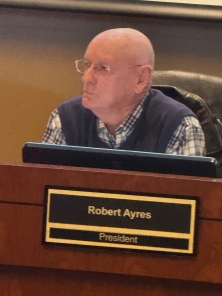 Farjood suggested that better outreach could boost meeting attendance. When Hall asked why so many people showed up at
Farjood suggested that better outreach could boost meeting attendance. When Hall asked why so many people showed up at 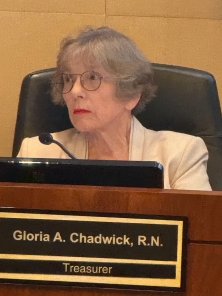 this meeting, when meetings are usually sparsely attended, Farjood replied, “Because I let them know about this,” drawing cheers from the audience.
this meeting, when meetings are usually sparsely attended, Farjood replied, “Because I let them know about this,” drawing cheers from the audience.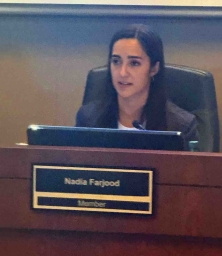 “Today is a dark day for the Grossmont Healthcare District,” concluded Farjood (photo, left), who added that increasing public access was a key part of her campaign. “No amount of years serving on this board can erase the message sent today—that working people cannot serve on this board.”
“Today is a dark day for the Grossmont Healthcare District,” concluded Farjood (photo, left), who added that increasing public access was a key part of her campaign. “No amount of years serving on this board can erase the message sent today—that working people cannot serve on this board.”
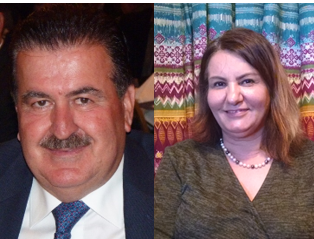 Photos by Miriam Raftery: Noori Barka and Dilkhwaz Ahmed, leaders of El Cajon nonprofits aiding immigrants and refugees, have contrasting views on deportations
Photos by Miriam Raftery: Noori Barka and Dilkhwaz Ahmed, leaders of El Cajon nonprofits aiding immigrants and refugees, have contrasting views on deportations